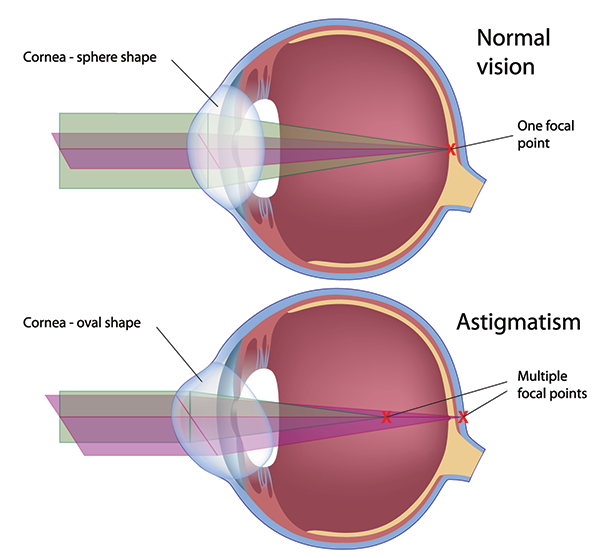What's an Astigmatism?
March 7, 2024
-
Categories:
- Eyecare,
- Eyeglasses,
- Contact Lenses,
- Sunglasses,

Understanding Astigmatism: A Common Vision Condition
Astigmatism, a prevalent eye condition affecting millions worldwide, arises from irregularities in the cornea's shape or sometimes the eye's lens. Unlike the perfectly round curvature found in a basketball, the cornea in individuals with astigmatism may resemble the shape of a football or the back of a spoon. This irregularity disrupts the even refraction of light entering the eye, leading to blurred or distorted vision.
Causes and Development of Astigmatism
While some individuals inherit astigmatism, it can also develop or worsen over time due to factors such as eye injuries, certain medical conditions, or aging processes. Often, astigmatism coincides with other refractive errors like nearsightedness (myopia) or farsightedness (hyperopia).
Recognizing the Symptoms
Symptoms of astigmatism can vary in severity, including headaches, eye strain, fatigue, and difficulty focusing on objects at various distances. In children, astigmatism might manifest as challenges in academic performance due to difficulty reading or focusing.
Diagnosis and Regular Eye Exams
Diagnosing astigmatism requires a comprehensive eye examination conducted by an optometrist or ophthalmologist. Regular eye check-ups are crucial, especially for children, as astigmatism can sometimes go undetected. Early detection allows for timely intervention to prevent potential vision-related issues.
Managing Astigmatism with Corrective Lenses
Fortunately, astigmatism can be effectively managed with corrective lenses, offering clear and comfortable vision. Glasses and contact lenses are the primary modes of correction, tailored to the individual's prescription.
Eyeglasses for Astigmatism
For individuals with astigmatism, specially crafted eyeglasses correct vision by compensating for the irregular corneal shape. These glasses are designed to provide precise refractive correction, offering clarity and improved visual acuity. Eyeglasses remain a popular and accessible option for managing astigmatism, offering convenience and ease of use.
Contact Lenses for Astigmatism
Contact lenses, particularly toric lenses, offer an alternative solution for individuals seeking freedom from glasses. Toric lenses are specially designed to address the irregular corneal shape associated with astigmatism, providing clear and comfortable vision. Contact lenses offer flexibility and are suitable for various lifestyles, including sports and outdoor activities.
Surgical Options: Considerations and Limitations
While surgical procedures such as LASIK or PRK can permanently correct astigmatism by reshaping the cornea, they are typically reserved for individuals with stable vision and specific criteria determined by an eye care professional. Surgery may not be necessary or suitable for everyone, and the decision to undergo surgical intervention should be carefully considered after discussing all options with an eye care specialist.
Conclusion
Astigmatism, while common, is a manageable condition that can significantly impact quality of life if left untreated. Through regular eye care and appropriate treatment, individuals with astigmatism can enjoy clear and comfortable vision, minimizing associated symptoms and maximizing visual function. Whether through eyeglasses, contact lenses, or surgical intervention, effective management of astigmatism empowers individuals to lead active and fulfilling lives.